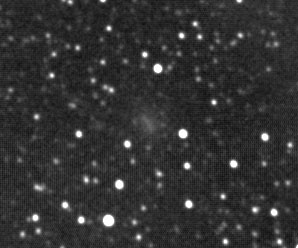Back in the day, it used to be that most new comets and asteroids were discovered by astronomers diligently sitting at their eyepieces, spending one cold night after another patiently scanning the skies. The advent of robotic astronomy changed that, and now the vast majority of all celestial newcomers are found automatically.
But Australian “amateur” astronomer Terry Lovejoy changed that last week: not only did he discover a comet – which isn’t that unusual, though still cool – but it turns out to be a sungrazer, a comet that plunges deep down to the center of the solar system, practically skimming the Sun’s surface.
Here is Lovejoy’s discovery image:
This is a combination of three images; the comet moves between exposures a bit so he re-centered the comet in each shot and added them together. It’s the fuzzy blob in the middle of the frame. The comet’s official name is C/2011 W3 (Lovejoy), and on December 16th it will pass just about 880,000 km (500,000 miles) from the Sun’s surface – only a little bit more than than the radius of the Sun itself! 180,000 km (110,000 miles) – less than half the distance from the Earth to the Moon!* This may be a death dive, since many such comets don’t survive the intense heat of the Sun from that distance. Comets are composed of lots of rock held together by ice, so when the ice vaporizes, the comets disintegrates.
 Michael Mattiazzo took the shot shown here of the comet on the evening of December 2. It’s a combination of ten short exposures lasting only minutes in total, but the comet moves enough during that time to trail in the final image. As you can see, it’s faint but moving rapidly as it heads down to its rendezvous with the Sun. You can also see more images of it at Astro Bob’s website.
Michael Mattiazzo took the shot shown here of the comet on the evening of December 2. It’s a combination of ten short exposures lasting only minutes in total, but the comet moves enough during that time to trail in the final image. As you can see, it’s faint but moving rapidly as it heads down to its rendezvous with the Sun. You can also see more images of it at Astro Bob’s website.
Sometimes these sungrazer comets – technically called Kreutz family comets, after the man who figured out they all came from the same parent comet – survive their passage and sometimes they don’t. Sometimes they also get bright enough to be seen with the naked eye, though 2011 W3 is pretty faint right now and probably won’t brighten. But comets are difficult to predict; each is different and can surprise us. If this one flares up I’ll be sure to let you know.
This is a pretty good find by Mr. Lovejoy: most sungrazer comets are first seen when they appear in data from the SOHO solar observing satellite, already very near the Sun. It’s hard to find them when they’re far from the Sun since they’re usually so faint, and in fact this is the first such sungrazing comet found from the ground in over 40 years! So it’s quite a nice discovery. Congrats to Mr. Lovejoy, and we’ll have to see what happens to his comet over the next couple of weeks!
Image credits: Terry Lovejoy, courtesy José Luis Galache; Michael Mattiazzo. Both used by permission.
* I originally found a set of numbers that gave the closest approach distance to the Sun of 880,000 km, but turns out that was the distance to the Sun’s center. Subtracting the Sun’s radius of 695,000 km yields the surface-skimming distance of roughly 180,000 km. My apologies for the error.
Related posts:
- The comet and the Coronal Mass Ejection
- NASA’S SDO captures final moments of a comet streaking across the Sun
- Amazing video of comet on a solar death dive
- Ten Things You Don’t Know About Comets